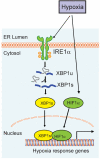XBP1 promotes triple-negative breast cancer by controlling the HIF1α pathway
- PMID: 24670641
- PMCID: PMC4105133
- DOI: 10.1038/nature13119
XBP1 promotes triple-negative breast cancer by controlling the HIF1α pathway
Abstract
Cancer cells induce a set of adaptive response pathways to survive in the face of stressors due to inadequate vascularization. One such adaptive pathway is the unfolded protein (UPR) or endoplasmic reticulum (ER) stress response mediated in part by the ER-localized transmembrane sensor IRE1 (ref. 2) and its substrate XBP1 (ref. 3). Previous studies report UPR activation in various human tumours, but the role of XBP1 in cancer progression in mammary epithelial cells is largely unknown. Triple-negative breast cancer (TNBC)--a form of breast cancer in which tumour cells do not express the genes for oestrogen receptor, progesterone receptor and HER2 (also called ERBB2 or NEU)--is a highly aggressive malignancy with limited treatment options. Here we report that XBP1 is activated in TNBC and has a pivotal role in the tumorigenicity and progression of this human breast cancer subtype. In breast cancer cell line models, depletion of XBP1 inhibited tumour growth and tumour relapse and reduced the CD44(high)CD24(low) population. Hypoxia-inducing factor 1α (HIF1α) is known to be hyperactivated in TNBCs. Genome-wide mapping of the XBP1 transcriptional regulatory network revealed that XBP1 drives TNBC tumorigenicity by assembling a transcriptional complex with HIF1α that regulates the expression of HIF1α targets via the recruitment of RNA polymerase II. Analysis of independent cohorts of patients with TNBC revealed a specific XBP1 gene expression signature that was highly correlated with HIF1α and hypoxia-driven signatures and that strongly associated with poor prognosis. Our findings reveal a key function for the XBP1 branch of the UPR in TNBC and indicate that targeting this pathway may offer alternative treatment strategies for this aggressive subtype of breast cancer.
Figures














Comment in
-
Breast cancer: Hypoxia and XBP1S.Nat Rev Cancer. 2014 May;14(5):295. doi: 10.1038/nrc3731. Epub 2014 Apr 10. Nat Rev Cancer. 2014. PMID: 24722430 No abstract available.
-
An unexpected alliance between stress responses to drive oncogenesis.Breast Cancer Res. 2014 Nov 6;16(6):471. doi: 10.1186/s13058-014-0471-1. Breast Cancer Res. 2014. PMID: 25927911 Free PMC article.
References
-
- Hanahan D, Weinberg RA. Hallmarks of cancer: the next generation. Cell. 2011;144:646–74. - PubMed
-
- Walter P, Ron D. The unfolded protein response: from stress pathway to homeostatic regulation. Science. 2011;334:1081–6. - PubMed
-
- Yoshida H, Matsui T, Yamamoto A, Okada T, Mori K. XBP1 mRNA is induced by ATF6 and spliced by IRE1 in response to ER stress to produce a highly active transcription factor. Cell. 2001;107:881–91. - PubMed
Publication types
MeSH terms
Substances
Associated data
- Actions
Grants and funding
LinkOut - more resources
Full Text Sources
Other Literature Sources
Molecular Biology Databases
Research Materials
Miscellaneous

